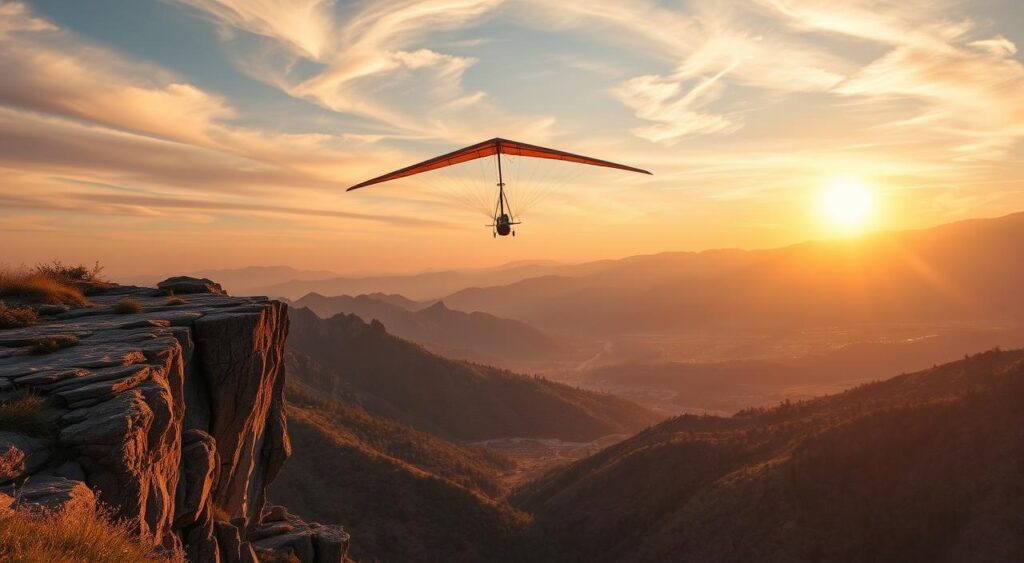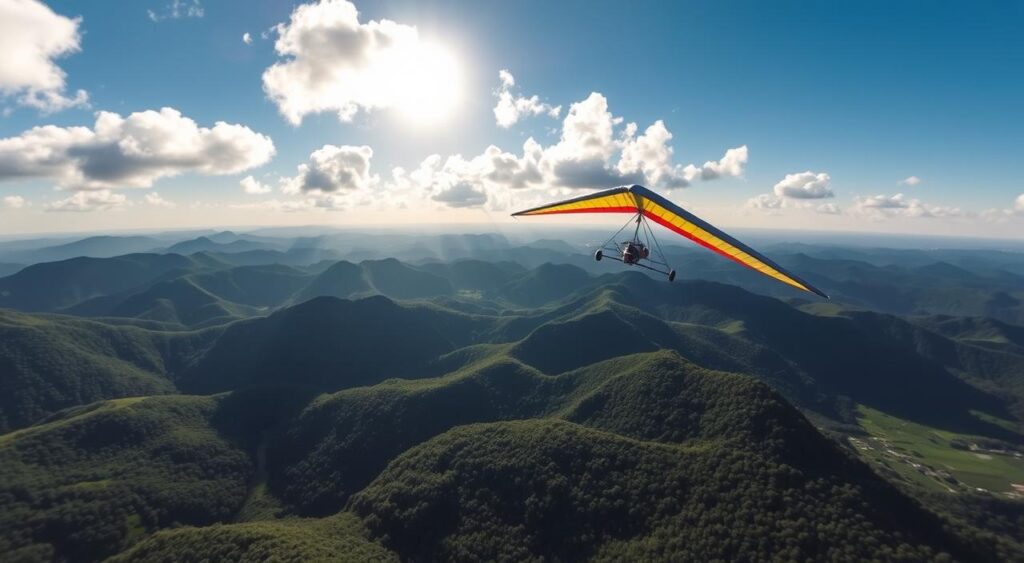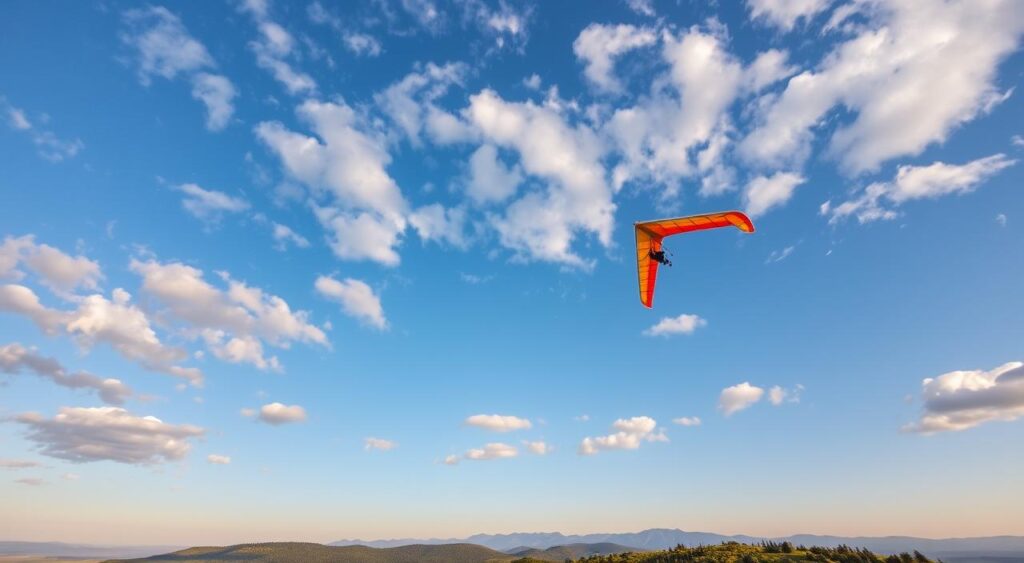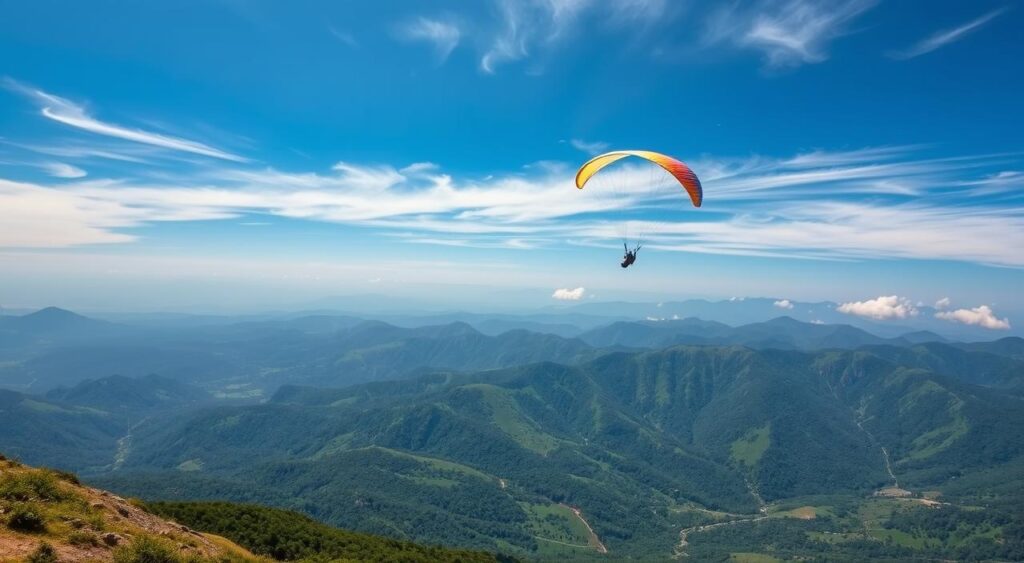Hang gliding is an exciting aerial sport that lets you fly through the skies. It’s an exhilarating way to look down on the planet. This guide will show you how to fly, stay safe, and enjoy the view.
You’ll learn about hang gliding, paragliding, and competitions. It’s your chance to become an adventurer and have an amazing time in the air.
Table of Contents
A Thrilling Introduction to Hang Gliding
Many dream of flying like birds, but hang gliding makes this dream real. It’s not just for the bravest. With the right help, anyone can enjoy the thrill of hang gliding experience.
An experienced hang glider pilot once said, “I thought hang gliding was only for the bold.” But now, it’s more open to everyone who wants to unleash their inner adventurer.
Unleash Your Inner Adventurer
Hang gliding has a long history, starting in the late 19th century. The 1960s saw a big change with the Rogallo wing. This made the sport more popular and easier to try.
Today’s hang gliding gear has a strong frame and a fabric wing. It’s designed for smooth flight. To learn, you need to be strong and agile. You must also be good at balancing and coordinating.
“The moment you take off, the thrill of hang gliding takes over. It’s an experience like no other, soaring through the skies with the wind in your face and the world below you.”
Hang gliding is perfect for those who love excitement. It’s more challenging than paragliding, but the feeling of flying alone is unmatched.
The Mechanics of Hang Gliding
Hang gliding fans love the thrill of flying high. But have you ever thought about the complex mechanics behind it? The design and structure of hang gliders are key to their great performance and safety.
The heart of a hang glider is its unique triangular shape. It has an aluminum or composite frame for strength. The sail, made of strong synthetic materials like polyester, is designed for speed and control.
Paragliders, on the other hand, use a fabric-cell wing without a metal frame. This makes them different in size, weight, and how they fly. Knowing these differences helps pilots understand the engineering behind their choice of flight.
| Feature | Hang Glider | Paraglider |
|---|---|---|
| Frame | Aluminum or composite | Fabric-cell wing, no metal frame |
| Sail/Wing | Synthetic material (e.g., polyester) | Fabric-cell construction |
| Size | Generally larger and heavier | Typically smaller and lighter |
| Flight Characteristics | Higher speeds, improved aerodynamics | More akin to parachute, lower speeds |
The detailed design and build of hang gliders show the engineering wonders of flight. By knowing the mechanics, pilots can truly appreciate the skill needed to fly with grace and control.
“The magic of flight is not just in the exhilaration of the journey, but in the elegant engineering that makes it possible.”
Launching Techniques for a Smooth Takeoff

Mastering the Art of Lift
Hang gliding is all about skill and precision, especially when launching. Pilots need at least 40 km/h of wind to take off. They must work with their instructor for a smooth start.
First, the pilot checks the hang glider. They make sure everything, from the helmet to the brake lines, is ready. Then, they use their leg muscles for a sharp pull on the canopy.
This quick pull inflates the canopy and creates lift. Beginners might use their arms first, leading to an uneven start. As the canopy rises, the pilot keeps pulling forward to fight against wind drag.
Once in the air, pilots learn to control their flight. They use their body and the glider’s controls to navigate. They master turns, flare, and pitch control. They also find and use air currents to stay aloft longer and fly farther.
| Key Factors for a Smooth Hang Glider Takeoff | Beginner Pilots | Experienced Pilots |
|---|---|---|
| Canopy Preparation Time | Longer | Shorter |
| Harness Connection | May prefer to keep permanently connected | More flexible in harness handling |
| Canopy Raising Technique | Often use arm muscles initially, leading to asymmetrical inflation | Rely on powerful leg muscles for a quick, stable takeoff |
| Handling Strong Winds | May experience surprising drag forces | Maintain forward pull force to overcome backward drag |
Learning to launch and use lift well lets pilots fly with confidence. They unlock the thrill of this exciting sport.
HANG GLIDING: A Journey Through the Clouds

Hang gliding is all about the thrill of flying. John Harris, a pioneer in this sport, once said, “Before this moment, I had never been so taken away from what I was seeing. Under me was the most beautiful scenery I had experienced, and I was in awe.” It offers a unique view, letting pilots feel the wind and see the world from above.
The feelings of hang gliding are amazing. Harris shared, “Holding my hands straight out like a bird with the wind under my arms right when I went over the mountains” captures the freedom and connection with nature. The 50th anniversary of Harris’ historic flight off Grandfather Mountain in 1974 will be celebrated in 2024, marking a significant milestone in the evolution of hang gliding.
Hugh Morton, who fell in love with hang gliding after seeing Harris fly, helped promote the sport worldwide. Morton’s passion made Grandfather Mountain a hub for hang gliding in the Southeast, inspiring many to fly.
Today, hang gliding and paragliding are enjoyed by tens of thousands worldwide. The book “Head in the Clouds” celebrates the first 50 years of free flying, showing the sport’s lasting appeal.
“Holding my hands straight out like a bird with the wind under my arms right when I went over the mountains.”
Hang gliding offers a journey through the clouds that changes us. It connects us to nature and sparks wonder and adventure. As we approach the 50th anniversary of John Harris’ flight, his legacy continues to inspire and captivate those who dare to fly.
| Key Dates and Events | Details |
|---|---|
| 1974 | John Harris takes his historic hang gliding flight off Grandfather Mountain, marking the beginning of hang gliding’s rise to prominence. |
| 1974 | Harris is joined by two friends, Vernon Collins and Ronnie Whitlow, from Portsmouth, Virginia, who also flew off the mountain on the same day. |
| 1974 | Harris and his friends did a test flight off Hump Mountain the day before their Grandfather Mountain flight to gain experience flying off mountains. |
| 1974 | Harris made two flights off Grandfather Mountain, the first launching from an overlook with a 50-60 foot drop to the tree line and the second launching from the 400-foot cliff peak. |
| 2024 | The 50th Anniversary of Harris’ flight will be celebrated at Grandfather Mountain on July 27th with various activities and events open to the public. |
Weather Patterns and Safety Protocols

Ensuring a Secure Flight
Hang gliding is an exciting sport that requires understanding weather and safety. Pilots must watch the hang gliding weather conditions closely. They need to be ready for changes in wind and air.
Using hang gliding safety rules is crucial. Experts say hang gliding is safer than driving, thanks to reserve parachutes and skilled instructors.
But, hang gliding risk management is still important. Pilots must be quick to react to sudden weather changes. By following safety rules, they can enjoy their flights safely.
“Hang gliding is fifteen times safer than driving and about as safe as hiking or running, thanks in part to the use of reserve parachutes and the expertise of highly trained instructors.”
- Continuous training and skill development are essential for enhancing proficiency as a hang gliding professional.
- Many insurance companies offer seemingly attractive and low-cost policies, but cheap policies often fail to provide adequate coverage when needed the most.
- XINSURANCE offers tailored insurance solutions specifically designed for high-risk sports like hang gliding, with a deep understanding of the unique needs of the sport.
Hang gliders can reach new heights by staying informed and following safety rules. With the right preparation, the sky is their limit.
Paragliding: A Complementary Adventure

Hang gliding is the main focus of this guide, but let’s also look at paragliding. Paragliding is a fast-growing air sport that offers a thrilling aerial experience. It’s a great way to add excitement to your adventures.
Paragliders are like parachutes, with a fabric-cell wing and an upright pilot seat. They need about 20 km/h of wind to take off. This makes them easier to start for some. But, hang gliders can go faster and do more aerial tricks.
It’s key to understand the differences between paragliding and hang gliding. Both are exciting, but they suit different tastes and skill levels.
Paragliding is open to all ages and jobs. Tandem flights last 10 to 20 minutes, and the whole experience is about an hour. Hang gliding, on the other hand, needs more skill and fitness. It’s tougher for some.
Exploring paragliding and hang gliding together lets adventurers pick what fits them best. This way, everyone can have an unforgettable flight experience.
Landing Techniques for a Smooth Descent
Learning to land a hang glider is as important as taking off. Pilots need to watch the wind and use the controls well. They also need to position their body right. With the right techniques, you can land smoothly and safely, just like you took off.
The flare is a key part of landing. As you get close to the ground, raise the nose of the glider by 2-3 degrees. This helps slow down your fall. The Gulfstream G650 loses about 5 knots of speed during this, making landing smoother.
It’s also important to keep an eye on how high you are and where you’re going to land. Gulfstream says pilots look 754 feet ahead of the wheels during a 3-degree glide path. If you forget to flare, you might land too far ahead. So, it’s vital to control the glider well and follow the landing steps carefully.
| Hang Glider Landing Techniques | Description |
|---|---|
| Flare Initiation | Increase pitch attitude by 2-3 degrees when main gear is 20-30 feet above the runway |
| Touchdown Point | Pilot’s eyes positioned 754 feet ahead of the aircraft’s wheels during a 3-degree glide path |
| Speed Loss During Flare | Gulfstream G650 experiences a 5-knot speed loss during the rotation to flare |
By learning these landing techniques, you can land smoothly and safely. This makes every flight enjoyable and safe. Always be ready and focused when landing to ensure a successful return to the ground.
Gliding Competitions and Events
Elevating Your Passion
For those who love hang gliding, competitive gliding is an exciting chance to grow your passion. Around the world, hang gliding competitions and events celebrate skilled pilots. They also challenge the limits of flying.
Events like the European Championship FAI Class 1 and the Pan-American Paragliding Championships are top-notch. They feature cross-country races, aerial stunts, and precise landings. Whether you’re a pro or just starting, these competitions can make your hang gliding experience more thrilling.
The 2024 event calendar is packed with exciting competitions. Highlights include the World Junior Paragliding Championships in Tolmin, Slovenia, and the World Paragliding Aerobatics Championships in Oludeniz, Turkey. Next year, the World Paragliding Championships in Andradas, Brazil, and the World HG Class 1, 5, Women in Ager, Spain, will be in the spotlight.
If you want to join these events, the bidding for 2027 competitions is open. You can compete in World Paragliding XC Championships or World Hang Gliding Class 1, 2, 5, and Sport. This is your chance to show off your skills on a global stage.
Whether you want to compete or just watch, hang gliding competitions are unforgettable. They showcase the bravery and skill of pilots, leaving everyone in awe.
Flight Instruments and Technology
Hang gliding is getting more advanced, thanks to new flight instruments and technology. These tools give pilots important data and insights. This helps them fly more safely and precisely.
The altimeter is a key tool, measuring how high the glider is. It works with the variometer to track changes in height. GPS is also used, giving pilots their exact location and direction.
Flight computers and electronics have made hang gliding even better. They track airspeed, wind direction, and more. This data helps pilots make better decisions and fly better.
| Instrument | Average Price Range | Key Features |
|---|---|---|
| Altivariometers without BipBip display | 50 to 100 euros | Measures altitude and rate of climb/descent |
| Alti Variometers with display | 200 to 300 euros | Includes altitude and variometer data with visual display |
| Alti Variometer GPS | 350 to 500 euros | Integrates GPS navigation with altitude and variometer functions |
| Alti Variometer GPS competition | 500 to 1000 euros | Advanced GPS, altimeter, and variometer features for competitive pilots |
Hang gliding technology keeps getting better, offering many options for pilots. Whether you’re new or experienced, There is something for everyone, regardless of experience level. These tools make flying more exciting and safe.
Cross-Country Flying: Exploring New Horizons
For the bravest hang glider pilots, flying over new lands is a big dream. Cross-country flying means flying long distances, from dozens to hundreds of miles. It needs careful planning, great flying skills, and knowing the skies well.
These long hang glider cross-country flights are exciting challenges. Pilots face different weather, find good air currents, and make smart choices for a safe trip. Starting can be tough, but finishing a long long-distance hang gliding trip is incredibly rewarding.
By going on these hang gliding exploration trips, pilots see new places, improve their skills, and feel free in the clouds. The joy and pride of flying across the country is a big reason why some pilots love it so much.
Whether it’s dealing with tough weather, learning to rise with thermals, or enjoying amazing views, cross-country hang gliding is an amazing adventure. It’s a thrilling sky exploration, a sign of human’s love for flying, and a journey that inspires pilots worldwide.
Conclusion
Hang gliding is an amazing aerial sport that mixes speed, flight wonder, and natural beauty. It starts with excitement as you launch into the air. Then, you learn to land safely, making every flight an adventure.
This guide has covered everything from how it works to staying safe. It’s perfect for both newbies and experienced pilots. Hang gliding offers a unique and unforgettable experience.
With the right prep and a brave heart, you can conquer the skies. So, go ahead and experience the thrill of hang gliding. Remember, safety, learning, and respect for nature are key.
These values will help you grow and make lasting memories. Hang gliding opens doors to adventure, friendship, and personal growth. It changes lives in amazing ways.
Now, it’s time to explore the skies and find your true potential. Take the leap, spread your wings, and soar. The world of hang gliding awaits, filled with unforgettable moments and new discoveries.
